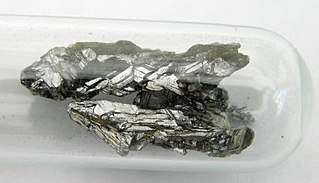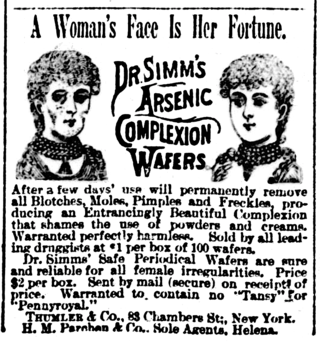
Arsenic is a chemical element with the symbol As and atomic number 33. Arsenic occurs in many minerals, usually in combination with sulfur and metals, but also as a pure elemental crystal. Arsenic is a metalloid. It has various allotropes, but only the grey form, which has a metallic appearance, is important to industry.

A toxic heavy metal is any relatively dense metal or metalloid that is noted for its potential toxicity, especially in environmental contexts. The term has particular application to cadmium, mercury and lead, all of which appear in the World Health Organization's list of 10 chemicals of major public concern. Other examples include manganese, chromium, cobalt, nickel, copper, zinc, silver, antimony and thallium.

Infant formula, also called baby formula, simply formula, baby milk or infant milk, is a manufactured food designed and marketed for feeding to babies and infants under 12 months of age, usually prepared for bottle-feeding or cup-feeding from powder or liquid. The U.S. Federal Food, Drug, and Cosmetic Act (FFDCA) defines infant formula as "a food which purports to be or is represented for special dietary use solely as a food for infants by reason of its simulation of human milk or its suitability as a complete or partial substitute for human milk".

Arsenic poisoning is a medical condition that occurs due to elevated levels of arsenic in the body. If arsenic poisoning occurs over a brief period of time, symptoms may include vomiting, abdominal pain, encephalopathy, and watery diarrhea that contains blood. Long-term exposure can result in thickening of the skin, darker skin, abdominal pain, diarrhea, heart disease, numbness, and cancer.

Malted milk or malt powder is a powdered gruel made from a mixture of malted barley, wheat flour, and evaporated whole milk powder. The powder is used to add its distinctive flavor to beverages and other foods, but it is also used in baking to help dough cook properly.

Melamine is an organic compound with the formula C3H6N6. This white solid is a trimer of cyanamide, with a 1,3,5-triazine skeleton. Like cyanamide, it contains 67% nitrogen by mass, and its derivatives have fire-retardant properties due to its release of nitrogen gas when burned or charred. Melamine can be combined with formaldehyde and other agents to produce melamine resins. Such resins are characteristically durable thermosetting plastic used in high pressure decorative laminates such as Formica, melamine dinnerware including cooking utensils, plates, plastic products, laminate flooring, and dry erase boards. Melamine foam is used as insulation, soundproofing material and in polymeric cleaning products, such as Magic Eraser.

Powdered milk, also called milk powder, dried milk, or dry milk, is a manufactured dairy product made by evaporating milk to dryness. One purpose of drying milk is to preserve it; milk powder has a far longer shelf life than liquid milk and does not need to be refrigerated, due to its low moisture content. Another purpose is to reduce its bulk for the economy of transportation. Powdered milk and dairy products include such items as dry whole milk, nonfat (skimmed) dry milk, dry buttermilk, dry whey products and dry dairy blends. Many exported dairy products conform to standards laid out in Codex Alimentarius.

Morinaga Milk Industry Co., Ltd. is a milk products and sweets company based in Tokyo, Japan, in operation since September 1, 1917. Their products include milk products, drinks, candy, confectioneries, and infant formula. Morinaga has distribution agreements with Mondelez International and Kalbe Farma. Its subsidiaries include Morinaga Hokuriku Dairy. Morinaga Milk celebrated its 100th anniversary in 2017. In addition to condensed milk and infant formula, products that it has offered since its founding, it has also produced a wide range of products based on milk, including Morinaga Milk, Bifidus Yogurt, Creap, and Mt. RAINIER CAFFE LATTE.
The four big pollution diseases of Japan were a group of man-made diseases all caused by environmental pollution due to improper handling of industrial wastes by Japanese corporations. The first occurred in 1912, and the other three occurred in the 1950s and 1960s.
Thallium poisoning is poisoning that is due to thallium and its compounds, which are often highly toxic. Contact with skin is dangerous and adequate ventilation should be provided when melting this metal. Many thallium compounds are highly soluble in water and are readily absorbed through the skin. Exposure to them should not exceed 0.1 mg per m2 of skin in an 8 hour time-weighted average.
Sanlu Group CO., Ltd. (SJZSGCZ) was a Chinese dairy products company based in Xinhua District, Shijiazhuang, the capital city of Hebei. It produced one of the oldest and most popular brands of infant formula in China. New Zealand's Fonterra owned 43% of Sanlu.

The 2008 Chinese milk scandal was a significant food safety incident in China. The scandal involved Sanlu Group's milk and infant formula along with other food materials and components being adulterated with the chemical melamine, which resulted in kidney stones and other kidney damage in infants. The chemical was used to increase the nitrogen content of diluted milk, giving it the appearance of higher protein content in order to pass quality control testing. 300,000 affected children were identified, among which 54,000 were hospitalized, according to the latest report in January 2009. The deaths of six babies were officially concluded to be related to the contaminated milk.
This timeline of the 2008 Chinese milk scandal documents how events related to the Chinese dairy products contamination by melamine unfolded. Complaints about kidney problems traced back to a brand of infant formula, subsequent discoveries of melamine contamination of liquid milk, and exported powdered milk of processed food products. The scandal decimated Chinese dairy exports, and re-exposed long-standing concerns about food security, corruption, lack of political checks and balances. Though the scandal came to attention in 2008, its roots can be traced back to events prior to 2008.
Toroku arsenic disease was a disease resulting from air and water pollution from a refinery at a mine at Toroku, located in Takachiho, Nishiusuki District, Miyazaki, Japan.

Food safety incidents in China have received increased international media scrutiny following the reform and opening of the country, and its joining the World Trade Organization. Urban areas have become more aware of food safety as their incomes rise. Food safety agencies in China have overlapping duties. The 2008 Chinese milk scandal and COVID-19 pandemic received the most attention among food safety incidents.
In 2013, a wide-scale recall of products sold by dairy producer Fonterra was announced after suspected botulism-causing bacteria were found during safety tests. The contaminated whey products had been sold to third parties who use it to produce infant formula and sports drinks. Approximately 1,000 tonnes of consumer product was affected by the recall across seven countries, but no cases of sickened consumers were reported. China, which imports most of its powdered milk from New Zealand, instituted a temporary ban on the import of the ingredient from New Zealand.

In 1900, more than 6,000 people in England were poisoned by arsenic-tainted beer, with more than 70 of the affected dying as a result. The food safety crisis was caused by arsenic entering the supply chain through impure sugar which had been made with contaminated sulphuric acid. The illness was prevalent across the Midlands and North West England, with Manchester being the most heavily affected.











